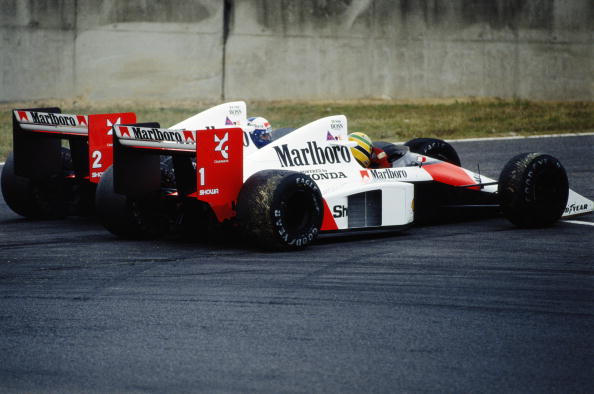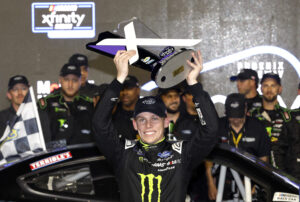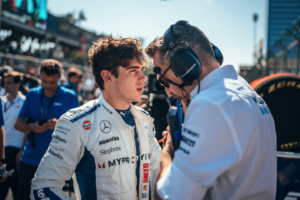Revisiting a classic Japanese Grand Prix. Boundaries between teammates were crossed & accusations of political game-playing rocked the sport.
1988 had seen one of the most dominant Formula 1 seasons in history, with McLaren-Honda racking up 14 wins from 15 races. Ayrton Senna had been recruited from Lotus and won the World Championship for the first time, edging out his team-mate and twice-World Champion, Alain Prost. The 1989 season was a case of continuity, with McLaren once again the class of the pack. But Senna and Prost’s once-cordial relationship turned contentious, giving their renewed title battle even more zesty Hollywood-style drama including that year’s visit to the Japanese Grand Prix.
Tensions that bubbled between Prost and Senna surfaced publicly after the second round in San Marino. Prost accused Senna of reneging on a pre-race agreement that whoever was first into the first corner on the first lap would be allowed to win. Senna obliged, but felt that this agreement did not count at the second time of asking. When the race was restarted after Gerhard Berger’s fiery crash, Senna duly overtook Prost at the Tosa hairpin. Many other suspicions were made from one to the other, with Prost apparently believing Senna had gained favor with Honda and possibly provided Senna with better engines. Senna, in turn, felt Prost’s supposed closeness to FISA President and compatriot, Jean-Marie Balestre, gave him an advantage amongst F1’s establishment.
The 1989 Japanese Grand Prix
By the time the F1 circus rolled into Japan, the situation was the mirror opposite of 1988. This time, it was Prost who had the title lead and could wrap it up in the Land of the Rising Sun. Senna had won two more races than Prost, but picked-up fewer points, with Prost’s moniker The Professor well-and-truly justified as he finished more races in points places.
In qualifying, Senna obliterated Prost and took Pole Position by a staggering 1.7 seconds. Instead, Prost focused on the car’s setup for the race, knowing that the McLaren cars were significantly faster than the remainder of the field and Senna was his only real opponent. Ever the wily fox, Prost had the Gurney flap on his car removed before the race, in the hope this would help him jump Senna off the line. The gamble paid off and Prost roared into the lead.
Suzuka has played host to a number of dramatic @F1 showdowns, but none more so than in 1989 – as Ayrton Senna and Alain Prost produced a clash for the ages 🤯
Decyfr Presents: 𝗦𝘂𝘇𝘂𝗸𝗮 𝟭𝟵𝟴𝟵 🇯🇵
(🎥 Courtesy F1 & Duke Video)#Decyfr #UnlockFandom #F1 #Senna #JapaneseGP pic.twitter.com/VMaqmZweJ7
— Decyfr GP (@DecyfrGP) October 4, 2022
The race settled with the McLarens pulling well away from their closest challengers – the Ferrari duo of Berger and Nigel Mansell. The Gurney flap removal gave Prost a straight-line speed advantage, but Senna began to reel Prost back in after pitting for a fresh set of tires. Once both Ferraris were out, the McLarens were seemingly on their own with Senna beginning to close the gap even more. As they approached the 48th lap of 53, he prepared to make his make-or-break maneuver.
McLaren Fireworks
Senna managed to have enough of a tow from Prost on the back straight and through the fast 130R that he lunged into the final chicane. Prost seemingly kept his line, turned in, and with nowhere else to go, the pair collided. Their wheels intertwined, it appeared as if both of them were out, confirming Prost’s third Drivers’ title. Senna refused to concede and signaled to the marshals to push-start him. They did, and Senna was able to subsequently bump-start down the escape road and rejoin the race, albeit with his front-wing hanging by a thread.
With a whole lap to complete as the wing finally vacated the rest of the car, Senna limped to the pits for a replacement. As he did so, the new 2nd-placed man, Benetton’s Alessandro Nannini, took the lead. With Senna now on a mission to get his lead back – and maintain his title challenge – he charged after the Italian. Senna caught him just a couple of laps later, overtaking him at the very spot he came together with Prost. Senna took the chequered flag, reducing the gap to just six points with the final round in Australia looming, but more drama was to come.
Podium Controversy
Discussions took place immediately to determine the outcome. Fans, teams, the media, and Prost waited to find out who would walk out onto the top step of the podium. Three drivers appeared, none of whom were Senna. Nannini was declared winner, with Williams’ Riccardo Patrese and Thierry Boutsen 2nd and 3rd respectively; Senna was disqualified for cutting the chicane via the escape road and Prost was officially Champion. Senna was livid and incredulous at what he perceived as an injustice, going as far as accusing Balestre of making the decision. The FISA denied this and noted that Ballestre wasn’t present when the stewards met.
McLaren officially lodged an appeal to the chagrin of Prost, who had already announced he was leaving the team to join Ferrari for the 1990 season. The disqualification was upheld, with further punishment of a $100,000 fine to Senna, as well as a six-month suspended ban. The debate has continued to this day as to where the fault lay, with many believing Senna was overambitious in his attempts, while others feel Prost began to turn into the corner earlier than he would normally have. The inter-team incident became the watershed moment in the rivalry between the two men and just a year later, Suzuka was again the setting for another title-deciding clash between them, with Senna deliberately running Prost off the road into turn one, securing him a second title.
Drama Overshadows Nannini’s Day
An incident of such infamy and controversy, Senna and Prost’s moment has been embedded into Japanese Grand Prix folklore. The event sadly overshadowed what proved to be the only win in the career of Alessandro Nannini. Popular and talented, Nannini was apparently courted by Ferrari for a future race seat, but his career ended a year later when a helicopter crash above his vineyard in Siena resulted in a severed forearm.
Although reattached, Nannini would never compete in Formula 1 again, denying fans the chance to witness a career that many felt would have fulfilled itself with many more wins and perhaps even World Championships. He was honored with two special tests in 1992 and 1996 with Ferrari and Benetton respectively, and was also successful in German Touring Cars, driving specially-adapted cars to accommodate his needs. Today, he owns a popular chain of cafes in Italy, originally started by his grandfather.






